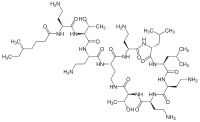
Photo from wikipedia
Abstract Background Prior data states that polymyxin B is renally cleared and thus required renal adjustments, however newer data suggests that polymyxin B undergoes non-renal clearance. With more aggressive dosing,… Click to show full abstract
Abstract Background Prior data states that polymyxin B is renally cleared and thus required renal adjustments, however newer data suggests that polymyxin B undergoes non-renal clearance. With more aggressive dosing, potential for increased nephrotoxicity is of concern. This study aims to determine whether time to acute kidney injury (AKI) differs between renally adjusted and non-adjusted doses of intravenous (IV) polymyxin B. Secondary objectives aim to evaluate incidence of AKI, length of stay (LOS), adverse reactions, and potential role of ascorbic acid in decreasing nephrotoxicity. Methods This retrospective chart review compared time to AKI in patients receiving renally adjusted and non-adjusted IV polymyxin B between Jan 2012 and Nov 2016. This study included patients who are at least 18 years old, received IV polymyxin B, and have creatinine clearance below 80 mL/minute. Patients were excluded if they had AKI (RIFLE criteria), received renal replacement therapy, or are pregnant prior to receipt of IV polymyxin B. Fine and Gray’s model for competing risks was used to predict the cumulative incidence function of AKI. Descriptive statistics, two-sample t-test, and Chi-square test were used as appropriate. Results Of the 132 patients screened, 54 met inclusion criteria (23 in the renally adjusted vs. 31 in the non-adjusted group). There was no statistical association between dosing type and time to AKI (P = 0.13). Incidence of nephrotoxicity was higher in the renally adjusted vs. non-adjusted groups (21.7% vs. 6.5% respectively). Mortality was higher in the renally adjusted vs. non-adjusted groups (17.4% vs. 6.5% respectively). LOS was greater in the renally adjusted vs. non-adjusted groups (16 vs. 14 days respectively, P = 0.26). All patients in the study received concomitant nephrotoxic agents (e.g., vancomycin, aminoglycosides). Ascorbic acid use was infrequent but, in the 4 patients who did receive it, none developed AKI. No difference in neurotoxicity, respiratory arrest, Clostridium difficile infections was seen. Conclusion No significant association between IV polymyxin B dosing type and time to AKI was found. Incidence of AKI, LOS, and mortality was higher in the renally adjusted group compared with the non-adjusted group. Ascorbic acid may mitigate the nephrotoxic potential of IV polymyxin B, but further studies are needed. Disclosures All authors: No reported disclosures.
Journal Title: Open Forum Infectious Diseases
Year Published: 2017
Link to full text (if available)
Share on Social Media: Sign Up to like & get
recommendations!